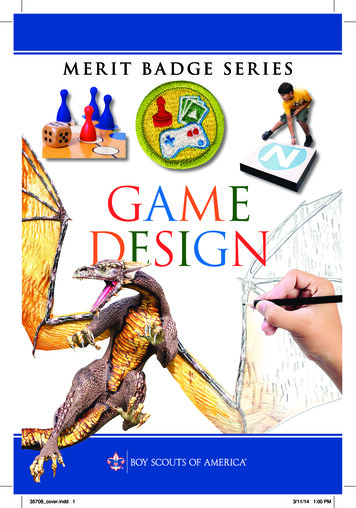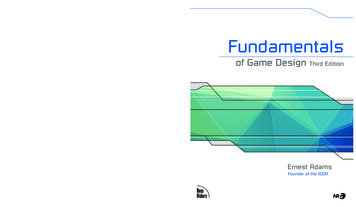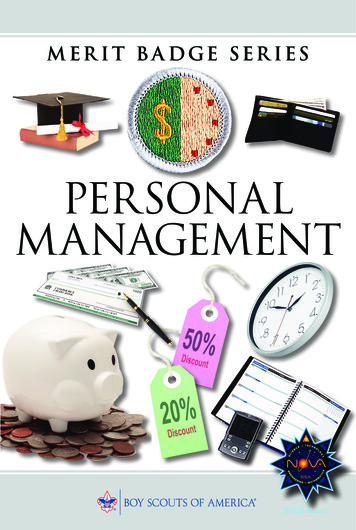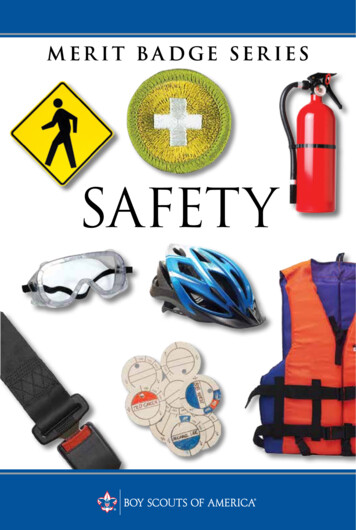
Transcription
GameDesign35708 cover.indd 13/11/14 1:00 PM
BOY SCOUTS OF AMERICAMERIT BADGE SERIESgame design“Enhancing our youths’ competitive edge through merit badges”
GGame Design1. Do the following:(a) Analyze four games you have played, each from a different medium.Identify the medium, player format, objectives, rules, resources, and theme(if relevant). Discuss with your counselor the play experience, what you enjoyin each game, and what you dislike. Make a chart to compare and contrastthe games.(b) Describe four types of play value and provide an example of a gamebuilt around each concept. Discuss with your counselor other reasons peopleplay games.2. Discuss with your counselor five of the following 17 game design terms.For each term that you pick, describe how it relates to a specific game.Thematic game elements: story, setting, charactersGameplay elements: play sequence, level design, interface designGame analysis: difficulty, balance, depth, pace, replay value,age appropriatenessRelated terms: single-player vs. multiplayer, cooperative vs. competitive, turnbased vs. real-time, strategy vs. reflex vs. chance, abstract vs. thematic3. Define the term intellectual property. Describe the types of intellectualproperty associated with the game design industry. Describe how intellectualproperty is protected and why protection is necessary. Define and give anexample of a licensed property.4. Do the following:(a) Pick a game where the players can change the rules or objectives (examples: basketball, hearts, chess, kickball). Briefly summarize the standard rulesand objectives and play through the game normally.(b) Propose changes to several rules or objectives. Predict how each changewill affect gameplay.(c) Play the game with one rule or objective change, observing how theplayers’ actions and emotional experiences are affected by the rule change.Repeat this process with two other changes.(d) Explain to your counselor how the changes affected the actions andexperience of the players. Discuss the accuracy of your predictions.123
5. Design a new game. Any game medium or combination of mediums isacceptable. Record your work in a game design notebook.(a) Write a vision statement for your game. Identify the medium, playerformat, objectives, and theme of the game. If suitable, describe the setting,story, and characters.(b) Describe the play value.(c) Make a preliminary list of the rules of the game. Define the resources.(d) Draw the game elements.You must have your merit badge counselor’s approval of yourconcept before you begin creating the prototype.6. Do the following:(a) Prototype your game from requirement 5. If applicable, demonstrate toyour counselor that you have addressed player safety through the rulesand equipment. Record your work in your game design notebook.(b) Test your prototype with as many other people as you need to meet theplayer format. Compare the play experience to your descriptions from requirement 5b. Correct unclear rules, holes in the rules, dead ends, and obvious ruleexploits. Change at least one rule, mechanic, or objective from your firstversion of the game, and describe why you are making the change. Play thegame again. Record in your game design notebook whether or not yourchange had the expected effect.(c) Repeat 6b at least two more times and record the results in your gamedesign notebook.7. Blind test your game. Do the following:(a) Write an instruction sheet that includes all of the information needed toplay the game. Clearly describe how to set up the game, play the game, andend the game. List the game objectives.(b) Share your prototype from requirement 6 with a group of players that hasnot played it or witnessed a previous playtest. Provide them with your instruction sheet(s) and any physical components. Watch them play the game, butdo not provide them with instruction. Record their feedback in your gamedesign notebook.(c) Share your game design notebook with your counselor. Discuss theplayer reactions to your project and what you learned about the game designprocess. Based on your testing, determine what you like most about yourgame and suggest one or more changes.124
8. Do ONE of the following:(a) With your parent’s permission and your counselor’s approval, visit with aprofessional in the game development industry and ask him or her about hisor her job and how it fits into the overall development process. Alternately,meet with a professional in game development education and discuss theskills he or she emphasizes in the classroom.(b) List three career opportunities in game development. Pick one andfind out about the education, training, and experience required for the profession. Discuss this with your counselor. Explain why this profession mightinterest you.Gardening1. Do the following:(a) Explain to your counselor the most likely hazards associated with gardeningand what you should do to anticipate, help prevent, mitigate, and respond tothese hazards.(b) Discuss the prevention of and treatment for health concerns that couldoccur while gardening, including cuts, scratches, puncture wounds, insectbites, anaphylactic shock, heat reactions, and reactions from exposure topesticides and fertilizers.2. Do the following:(a) Grow six vegetables, three from seeds and three from seed lings,through harvest.(b) Grow six flowers, three from seeds and three from seedlings,through flowering.3. Give the nutritional value of the following:(a) Three root or tuber crops(b) Three vegetables that bear above the ground(c) Three fruits4. Test 100 seeds for germination. Determine the percentage of seeds that germinate.Explain why you think some did not germinate.5. Visit your county extension agent’s office, local university agricultural college,nursery, or a botanical garden or arboretum. Report on what you learned.6. Explain to your counselor how and why honeybees are used in pollinatingfood crops and the problems that face the bee population today. Discuss whatthe impact to humanity would be if there were no pollinators.7. Identify five garden pests (insects, diseased plants). Recommend two solutionsfor each pest. At least one of the two solutions must be an organic method.125
Game Design ResourcesScouting LiteratureAthletics, Chess, Digital Technology,Inventing, Programming, and ScoutingHeritage merit badge pamphletsVisit the Boy Scouts of America’sofficial retail website (with yourparent’s permission) athttp://www.scoutstuff.org for acomplete listing of all merit badgepamphlets and other helpfulScouting materials and supplies.BooksBell, R.C. Board and Table GamesFrom Many Civilizations, revised ed.Dover Publications, 1979.Morehead, Albert H., Geoffrey MottSmith, and Philip D. Morehead.Hoyle’s Rules of Games, third revisedand updated ed. Signet, 2001.Sackson, Sid. Card Games Around theWorld. Dover Publications, 1994.Schell, Jesse. The Art of Game Design:A Book of Lenses. MorganKaufmann, 2008.Organizations and WebsitesAdventure Game Entertainment Software Rating BoardWebsite: http://www.esrb.orgRPG MakerWebsite: http://www.rpgmakerweb.comBotermans, Jack. The Book of Games:Strategy, Tactics & History. SterlingPublishing, 2008.Scratch ProjectMassachusetts Institute of TechnologyWebsite: http://scratch.mit.eduBrathwaite, Brenda, and Ian Schreiber.Challenges for Game Designers.Charles River Media, 2009.Unity 3DWebsite: http://unity3d.comKoster, Raph. A Theory of Fun forGame Design. Paraglyph Press, 2005.94 game designYoYo Games/GameMaker: o
94 game design Game Design Resources scouting Literature Athletics, Chess, Digital Technology, Inventing, Programming, and Scouting Heritage merit badge pamphlets Books Bell, R.C. Board and Table Games From Many Civilizations, revised ed. Dover Publications, 1979. Botermans, Jack. The Book










